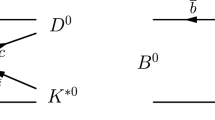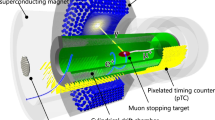Abstract
The decay B s →μ + μ − is one of the milestones of the flavor program at the LHC. We reappraise its Standard Model prediction. First, by analyzing the theoretical rate in the light of its main parametric dependence, we highlight the importance of a complete evaluation of higher-order electroweak corrections, at present known only in the large-m t limit, and leaving sizable dependence on the definition of electroweak parameters. Using insights from a complete calculation of such corrections for \(K\to\pi\nu\bar{\nu}\) decays, we find a scheme in which NLO electroweak corrections are likely to be negligible. Second, we address the issue of the correspondence between the initial and the final state detected by the experiments, and those used in the theoretical prediction. Particular attention is devoted to the effect of the soft radiation, which has not been discussed for this mode in the previous literature, and that can lead to O(10 %) corrections to the decay rate. The “non-radiative” branching ratio (which is equivalent to the branching ratio fully inclusive of bremsstrahlung radiation) is estimated to be (3.23±0.27)×10−9 for the flavor eigenstate, with the main uncertainty resulting from the value of \(f_{B_{s}}\), followed by the uncertainty due to higher order electroweak corrections. Applying the same strategy to B d →μ + μ −, we find for its non-radiative branching ratio (1.07±0.10)×10−10.
Similar content being viewed by others
Notes
Note that the presence of α em in the normalization of (4) is fictitious: we can eliminate it expressing α em/sin2 θ W in terms of G F and M W , thereby obtaining an expression that is well defined in the limit α em→0.
For the central value of M t in Table 1 we obtain \(m_{t}(m_{t})^{\overline{\mathrm{MS}}, \mathrm{QCD}}= 163.2~\mathrm{GeV}\) and \(m_{t}(m_{t})^{\overline{\mathrm{MS}}, \mathrm{QCD}+\mathrm{EW}}= 164.5~\mathrm{GeV}\).
We thank Tim Gershon and Matteo Palutan for useful discussions regarding this point.
References
R. Aaij et al. (LHCb collaboration), Phys. Rev. Lett. 108, 231801 (2012). arXiv:1203.4493 [hep-ex]
S. Chatrchyan et al. (CMS Collaboration), J. High Energy Phys. 1204, 033 (2012). arXiv:1203.3976 [hep-ex]
G. Aad et al. (ATLAS Collaboration), Phys. Lett. B 713, 387 (2012). arXiv:1204.0735 [hep-ex]
T. Aaltonen et al. (CDF Collaboration), Phys. Rev. Lett. 107, 239903 (2011). arXiv:1107.2304 [hep-ex]
P. Clarke, Talk on behalf of the LHCb Collaboration, presented at the 2012 Rencontres de Moriond, La Thuile, 3–10 March 2012. http://cdsweb.cern.ch/record/1429149/files/LHCb-TALK-2012-029.pdf
G. Buchalla, A.J. Buras, Nucl. Phys. B 398, 285–300 (1993)
G. Buchalla, A.J. Buras, Nucl. Phys. B 400, 225–239 (1993)
M. Misiak, J. Urban, Phys. Lett. B 451, 161–169 (1999). arXiv:hep-ph/9901278
G. Buchalla, A.J. Buras, Nucl. Phys. B 548, 309–327 (1999). arXiv:hep-ph/9901288
G. Buchalla, A.J. Buras, Phys. Rev. D 57, 216–223 (1998). arXiv:hep-ph/9707243
D. Yennie, S.C. Frautschi, H. Suura, Ann. Phys. 13, 379–452 (1961)
S. Weinberg, Phys. Rev. 140, B516–B524 (1965)
G. Isidori, Eur. Phys. J. C 53, 567–571 (2008). arXiv:0709.2439 [hep-ph]
K. de Bruyn, R. Fleischer, R. Knegjens, P. Koppenburg, M. Merk et al., arXiv:1204.1735 [hep-ph]
K. de Bruyn, R. Fleischer, R. Knegjens, P. Koppenburg, M. Merk et al., arXiv:1204.1737 [hep-ph]
G. Buchalla, A.J. Buras, M.E. Lautenbacher, Rev. Mod. Phys. 68, 1125–1144 (1996). arXiv:hep-ph/9512380
T. Inami, C. Lim, Prog. Theor. Phys. 65, 297 (1981)
K. Nakamura et al. (Particle Data Group), J. Phys. G 37, 075021 (2010)
K. Chetyrkin, J.H. Kuhn, M. Steinhauser, Comput. Phys. Commun. 133, 43–65 (2000). arXiv:hep-ph/0004189
B.A. Kniehl, A. Sirlin, Nucl. Phys. B 458, 35–51 (1996)
Particle Data Group, ref. [18]. The LEP Electroweak Working Group, http://lepewwg.web.cern.ch
S. Bethke, Eur. Phys. J. C 64, 689–703 (2009). arXiv:0908.1135 [hep-ph]
UTfit collaboration, www.utfit.org. Averages prepared with the PDG 2012 input. Statistical method described in M. Ciuchini et al., JHEP 0107, 013 (2001). arXiv:hep-ph/0012308
CKMfitter collaboration, ckmfitter.in2p3.fr. Statistical method described in J. Charles et al., Eur. Phys. J. C 41, 1–131 (2005). arXiv:hep-ph/0406184
Tevatron Electroweak Working Group, CDF and D0 Collaborations, arXiv:1107.5255 [hep-ex]
T. Aaltonen et al. (CDF Collaboration, D0 Collaboration), arXiv:1207.1069 [hep-ex]
J. Incandela, talk on behalf of the CMS Collaboration at CERN, 4th July, 2012
CMS Collaboration, HIG-12-020-pas
F. Gianotti, talk on behalf of the ATLAS Collaboration at CERN, 4th July, 2012
ATLAS Collaboration, ATLAS-CONF-2012-093
G. Aad et al. (ATLAS Collaboration), Phys. Lett. B 716, 1 (2012). arXiv:1207.7214 [hep-ex]
S. Chatrchyan et al. (CMS Collaboration), Phys. Lett. B 716, 30 (2012). arXiv:1207.7235 [hep-ex]
C. Davies, PoS LATTICE2011, 019 (2011). arXiv:1203.3862 [hep-lat]
R. Barbieri, M. Beccaria, P. Ciafaloni, G. Curci, A. Vicere, Phys. Lett. B 288, 95 (1992) [Erratum-ibid. B 312, 511 (1993)]. arXiv:hep-ph/9205238
R. Barbieri, M. Beccaria, P. Ciafaloni, G. Curci, A. Vicere, Nucl. Phys. B 409, 105 (1993)
J. Fleischer, O.V. Tarasov, F. Jegerlehner, Phys. Rev. D 51, 3820 (1995)
M. Misiak, private communication
C. Bobeth, P. Gambino, M. Gorbahn, U. Haisch, J. High Energy Phys. 0404, 071 (2004). arXiv:hep-ph/0312090
T. Huber, E. Lunghi, M. Misiak, D. Wyler, Nucl. Phys. B 740, 105 (2006). arXiv:hep-ph/0512066
M. Misiak, arXiv:1112.5978 [hep-ph]
J. Brod, M. Gorbahn, E. Stamou, Phys. Rev. D 83, 034030 (2011). arXiv:1009.0947 [hep-ph]
A.J. Buras, Phys. Lett. B 566, 115–119 (2003). arXiv:hep-ph/0303060
P. Dimopoulos et al. (ETM Collaboration), J. High Energy Phys. 1201, 046 (2012). arXiv:1107.1441 [hep-lat]
C. McNeile, C. Davies, E. Follana, K. Hornbostel, G. Lepage, Phys. Rev. D 85, 031503 (2012). arXiv:1110.4510 [hep-lat]
A. Bazavov et al. (Fermilab Lattice and MILC Collaborations), Phys. Rev. D 85, 114506 (2012). arXiv:1112.3051 [hep-lat]
B. Blossier, J. Bulava, M. Della Morte, M. Donnellan, P. Fritzsch et al., PoS LATTICE2011, 280 (2011). arXiv:1112.6175 [hep-lat]
H. Na, C.J. Monahan, C.T. Davies, R. Horgan, G.P. Lepage et al., arXiv:1202.4914 [hep-lat]
E. Gamiz, C.T. Davies, G.P. Lepage, J. Shigemitsu, M. Wingate (HPQCD Collaboration), Phys. Rev. D 80, 014503 (2009). arXiv:0902.1815 [hep-lat]
C. Bouchard, E. Freeland, C. Bernard, A. El-Khadra, E. Gamiz et al., PoS LATTICE2011, 274 (2011). arXiv:1112.5642 [hep-lat]
A.J. Buras, J. Girrbach, Acta Phys. Pol. B 43, 1427 (2012). arXiv:1204.5064 [hep-ph]
J. Laiho, E. Lunghi, R.S. Van de Water, Phys. Rev. D 81, 034503 (2010). arXiv:0910.2928 [hep-ph]. Updates available on http://latticeaverages.org/
P. Janot, Phys. Lett. B 223, 110 (1989)
F. Low, Phys. Rev. 110, 974–977 (1958)
D. Melikhov, N. Nikitin, Phys. Rev. D 70, 114028 (2004). arXiv:hep-ph/0410146
R. Aaij et al. (LHCb Collaboration), LHCb-CONF-2012-002
Acknowledgements
We thank Damir Becirevic, Joachim Brod, Fulvia de Fazio, Tim Gershon, Martin Gorbahn, Mikolaj Misiak, Matteo Palutan, Alexey Petrov and Emmanuel Stamou for useful comments and discussions. This work was supported by the EU ERC Advanced Grant FLAVOUR (267104), and by MIUR under contract 2008XM9HLM.
Author information
Authors and Affiliations
Corresponding author
Rights and permissions
About this article
Cite this article
Buras, A.J., Girrbach, J., Guadagnoli, D. et al. On the Standard Model prediction for \(\mathcal{B}(B_{s,d} \to \mu^{+} \mu^{-})\) . Eur. Phys. J. C 72, 2172 (2012). https://doi.org/10.1140/epjc/s10052-012-2172-1
Received:
Published:
DOI: https://doi.org/10.1140/epjc/s10052-012-2172-1




